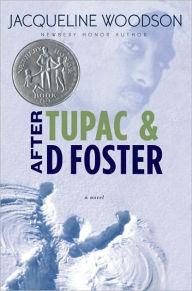After Tupac and D Foster by Jacqueline Woodson (Putnam, $16.99, 9780399246548/0399246541, 160p., ages 8-12, January 2008) Although one need not know who Tupac Shakur is to appreciate how deeply his music and life influence the three 11-year-old girls featured in Woodson's (If You Come Softly) novel, a trip to YouTube to witness his music will greatly enhance one's appreciation of the author's work here. The unnamed narrator and Neeka have grown up together on the same residential block of African-American families in Queens, N.Y. Neeka is the third of seven children whose parents are still together; the narrator is an only child who never knew her father. In the summer of 1994, D shows up on their street, with her green eyes, hair a "strange dark coppery color I'd never seen on a black girl--not naturally," and, even at age 11, a figure ("some body going on"). Readers will feel as if they are eavesdropping as the girls begin a tenuous conversation, and then become fast friends.
Although one need not know who Tupac Shakur is to appreciate how deeply his music and life influence the three 11-year-old girls featured in Woodson's (If You Come Softly) novel, a trip to YouTube to witness his music will greatly enhance one's appreciation of the author's work here. The unnamed narrator and Neeka have grown up together on the same residential block of African-American families in Queens, N.Y. Neeka is the third of seven children whose parents are still together; the narrator is an only child who never knew her father. In the summer of 1994, D shows up on their street, with her green eyes, hair a "strange dark coppery color I'd never seen on a black girl--not naturally," and, even at age 11, a figure ("some body going on"). Readers will feel as if they are eavesdropping as the girls begin a tenuous conversation, and then become fast friends.
The story unfolds in flashback, as the narrator tries to make sense of the time D was a part of her life, from age 11 to age 13: "D Foster showed up a few months before Tupac got shot that first time and left us the summer before he died." At first, the novel seems constricted by these parameters, which make for some awkward pacing at times. But as the story progresses, the framework lends credence to the narrator's experience. Isn't this just how a teenager would view her life, bookended by the defining moments of the girls' friendship and their favorite shared performer? Together Tupac and D Foster broaden Neeka and the narrator's views of the world around them. D travels by bus to parts of the city the other two girls have never seen ("She's like from another planet. The Planet of the Free"); they are not allowed even to leave their block. But their mothers prove not to be unreasonable: Neeka's older brother is chased down by police because he is jogging home from the basketball court ("Cops be trying to pull a brother down"), while her oldest brother serves time for a crime he did not commit. D tells the girls little about her past life in foster homes, instead revealing herself through the songs with which she most identifies--Tupac's "Brenda's Got a Baby" and "Dear Mama" in particular. His songs take us deep into the urban underbelly, where 12-year-old Brenda discards a baby she cannot care for, and where Tupac's pregnant mother sits in a jail cell because of her involvement with the Black Panthers. When D's mother comes to claim her, the girls begin to know the complexities of joy and pain intertwined--happiness for D, reunited with her mother, pain when their friend moves away. The narrator equates that loss with the loss she feels at Tupac's death, imagining them together, "D and Tupac. Tupac and D." Whether the friends are separated by miles or the grave, the distance seems unnavigable. Once again, Woodson reaches young people where they live and breathe, inviting them to re-examine their world through the eyes of full-bodied, memorable characters. --Jennifer M. Brown

